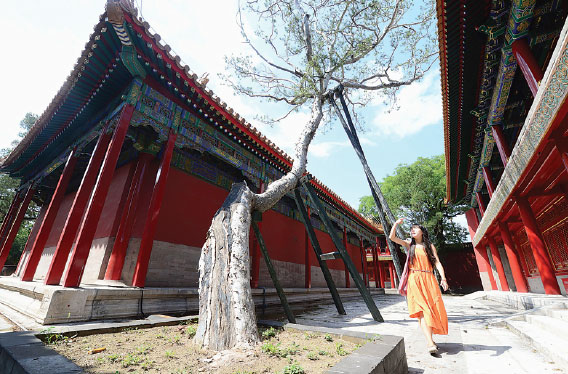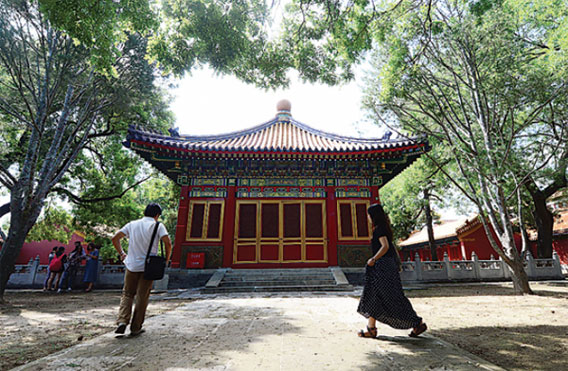Behind the veil of the imperial harem
Updated: 2015-10-03 08:08
By Wang Kaihao(China Daily)
|
|||||||||||
A part of the Forbidden City that was reduced to being a mere warehouse is about to open to the public
On a visit to the Palace Museum, also known as the Forbidden City, in Beijing recently I entered through the western gate and unexpectedly walked into a building site.
Building materials were scattered over the yard. Everyone was preparing for the opening of the museum's western area, but the gates leading to the most secret parts were still locked to outsiders.
|
Located to the west of the Gate of Great Ancestors in the inner court of the Forbidden City, Cining Palace is the essence of ancient palace architecture. Liu Chang / For China Daily |
The country's most powerful women once lived in that part of the Forbidden City, China's imperial palace, between 1420 to 1911.
However, since China's monarchy fell more than 100 years go, rollicking legends of empress dowagers and empresses have disappeared beneath overgrown wild grass.
When Shan Jixiang, director of the Palace Museum, announced this year that Cining Palace (the Palace of Compassion and Tranquility), the core of the western wing, was to open for visitors for the first time in July to celebrate the museum's 90th anniversary, it well and truly whetted appetites for tales of what went on inside the imperial harem.
So those who were hanging on for such things may be disappointed to know that few vestiges of the empresses' lives are left, Shan says. In fact, the once glorious Cining Palace was at one stage reduced to being nothing more than a warehouse for cultural relics.
With works behind schedule, the opening date was eventually pushed back from July to October.
Replicas of the boudoirs have often seen in TV operas related to the Qing Dynasty (1644-1911), but the real ones have remained stubbornly behind veils.
Cining Palace, built in 1536 during the Ming Dynasty (1368-1644) as a residence for the late emperors' concubines, is the most important architecture in the western wing of the Forbidden City. Many tour guides call it "the widows' yard". The widows were generally very young, it being common for an empress of that era to be widowed in her 20s or 30s.
After a major renovation in 1653, Empress Dowager Xiaozhuang (1613-88), concubine of the ruler Hong Taiji, became the head of the palace and remained so until her death 35 years later. In order to keep political connections with Manchu rulers of the Qing Dynasty, this empress dowager from the Mongol tribe of Horqin arranged two marriages for her son the Shunzhi Emperor (1638-61), the first Qing monarch to live in the Forbidden City.
However, Shunzhi disliked both, one of them so much that he relegated her to being a concubine. He married a Manchu noblewoman, but she died before she was designated empress. A year later the emperor himself died - at the age of 23.
Perhaps Xiaozhuang's poor relationship with her son was one of the greatest regrets of her life. Still, that did not prevent her becoming the most influential woman in the empire. When her grandson, the Kangxi Emperor (1654-1722) reigned, she was on hand to give him advice and nurtured him to become one of the most acclaimed monarchs in Chinese history.
In her era and the decades after, the Cining Palace was at its zenith, and grand birthday parties were held for empress dowagers. Some princesses were also married there.
"We are now intent on bringing the Cining Palace back to life," Shan says as he talks of it becoming the museum's first permanent exhibition hall specifically for ancient sculptures when it reopens.
For visitors, about 400 cream sculptures, statues and pottery figurines dating back to the Warring States Period (475-221 BC) housed in the museum will be a cultural feast.
Shan says that in addition to the main palace, the splendor of a 6,800-square-meter garden will greet visitors. The garden may well be the only place in the Forbidden City that reflects the empresses' and concubines' glorious days.
There are also plans to throw open the gates of the Great Buddhist Temple at the rear of the palace by the end of this year. There used to be about 70 Buddhist temples in the Forbidden City but none is open to the public.
Shan says the circumstances in which Buddhist articles were taken out of the Forbidden City 42 years ago, never to return. Prince Norodom Sihanouk of Cambodia, who was in exile in China, planned to visit White Horse Temple in Luoyang, Henan province, one of the earliest Buddhist temples in China, in 1973.
However, statues in its main hall had been destroyed during the "cultural revolution" (1966-76), so White Horse Temple officials asked the central government for permission to borrow those from Cining Palace.
"In the end, for some reason Sihanouk did not visit White Horse Temple, but the borrowed items never came back," Shan says.
"Nevertheless, the Great Buddhist Temple will be used to display our current highlighted collection of Tibetan Buddhism."
In the mid-19th century the empire's power declined sharply, and empress dowagers moved out of the palace as a cost-cutting measure. However, Li Xieping, a researcher at the Palace Museum, says most Qing empress dowagers in later times chose not to reside in Cining Palace, partly because they did not want to be overshadowed by Xiaozhuang.
For example, Li says, when Xiaozhuang died, the Kangxi Emperor wanted to use the palace as a mourning hall, something his ministers dissuaded him from doing.
Shoukang Palace (the Palace of Longevity and Health) thus became a complement.
This palace in the west wing of the museum, built in 1736, has also been used as a warehouse for cultural relics. Empress Xiaoshengxian (1693-1777) was the first hostess in the palace.
In recent years, Empresses in the Palace, also known as The Legend of Zhen Huan, was a popular 76-episode TV series that focused on conflicts and conspiracies in the royal harem during the Qing Dynasty.
The story of Zhen Huan, growing up from an innocent young concubine to the lady who governs the hare, is a fascinating one, so it is little surprise that the public keenly awaits the opening of the residence of Empress Xiaoshengxian - a prototype of Zhen Huan.
This woman, among the longest-living empress dowagers in Chinese history, gave birth to Emperor Qianlong (1711-99), one of two most influential Qing rulers other than Kangxi. When Xiaoshengxian turned 80, the emperor was over 60, but he managed to dance to celebrate his mother's birthday.
Shan says Shoukang Palace will open next month after renovations are complete.
Other empress dowagers lived in the palace, too, but Shan says the era of Xiaoshengxian was chosen as a major reference point because of her status. About 70 cultural relics related to her will also be on display.
"Her virtue as a mother and deep emotional connections with Qianlong will come through," Shan says. "The public will also be given an insight into the flourishing Qianlong reign."
That era was the grand finale of the heyday of China's feudal empires.
Early Qing Dynasty members
Major royal family members in early Qing Dynasty:
Nurhaci (1559-1626), ruler of Later Jin Dynasty (predecessor of Qing) 1616-26
Hong Taiji (1592-1643), ruler of Later Jin and Qing (Later Jin was renamed during his reign) 1626-43
Empress Dowager Xiaozhuang (1613-88)
Shunzhi Emperor or Fulin (1638-61), reigned 1643-61, and the first Qing ruler to live in the Forbidden City after Qing took over Beijing in 1644
Kangxi Emperor or Xuanye (1654-1722), reigned 1661-22
Yongzheng Emperor or Yinzhen (1678-1735), reigned 1722-35
Empress Dowager Xiaoshengxian (1693-1777)
Qianlong Emperor or Hongli (1711-99), reigned 1735-96
wangkaihao@chinadaily.com.cn
|
Inside Cining Palace. Liu Chang / For China Daily |
(China Daily 10/03/2015 page1)
Today's Top News
British boy, 15, gets life sentence over Anzac Day attack plot
EDF chief believes Chinese firms will take 40% stake in Hinkley nuclear project
Hot spots impose caps on visitor numbers during holiday period
Initiative looks to UK maritimes services
Movies Midas touch anticipated amid economic slowdown
Surfing in the air brings Internet to the skies but concerns linger
Russia starts airstrikes against terrorists in Syria
Li: China will meet main goals
Hot Topics
Lunar probe , China growth forecasts, Emission rules get tougher, China seen through 'colored lens', International board,
Editor's Picks

|

|

|

|

|

|








